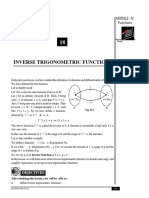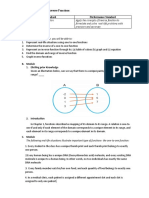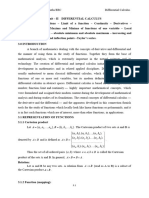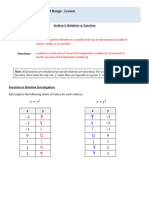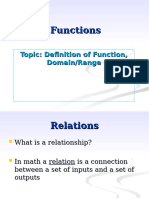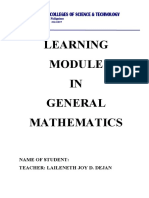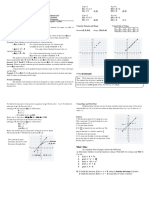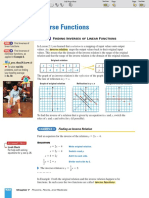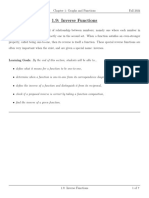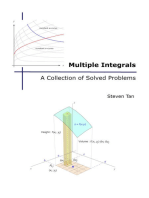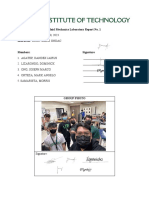M1 Algebraic Functions For Async PDF
M1 Algebraic Functions For Async PDF
Uploaded by
Luis FonbuenaCopyright:
Available Formats
M1 Algebraic Functions For Async PDF
M1 Algebraic Functions For Async PDF
Uploaded by
Luis FonbuenaOriginal Title
Copyright
Available Formats
Share this document
Did you find this document useful?
Is this content inappropriate?
Copyright:
Available Formats
M1 Algebraic Functions For Async PDF
M1 Algebraic Functions For Async PDF
Uploaded by
Luis FonbuenaCopyright:
Available Formats
9/18/21
Asynchronous/
Enrichment
Class
COE0001
1 2
Every function y = f(x) has an inverse relation x = f(y).
Relation & Function; Domain & Range
Function y = |x| + 1 Inverse relation x = |y| + 1
x y x y
Operations of Functions; Inverse of a 2 2
1 3 1 3
Functions
0 2 0 2
Key Points Types of Functions -1 1 -1 1
-2 -2
Domain Range Range Domain
Divisions of Polynomials The ordered pairs of :
y = |x| + 1 are {(-2, 3), (-1, 2), (0, 1), (1, 2), (2, 3)}.
The Remainder & Factor Theorem x = |y| + 1 are {(3, -2), (2, -1), (1, 0), (2, 1), (3, 2)}.
The inverse relation is not a function. It pairs 2 to both -1 and +1.
C o p y rig h t © b y H o u g h to n M ifflin C o m p a n y , In c . A ll rig h ts re s e rv e d . 4
3 4
Inverse Relation
Engr. Ma. Editha A. Grande, PECE
1
9/18/21
The ordered pairs of the function f are reversed to To find the inverse of a relation algebraically, interchange x
produce the ordered pairs of the inverse relation. and y and solve for y.
Example: Given the function Example: Find the inverse relation algebraically for the
f = {(1, 1), (2, 3), (3, 1), (4, 2)}, its domain is {1, 2, 3, 4} function f(x) = 3x + 2.
and its range is {1, 2, 3}. y = 3x + 2 Original equation defining f
The inverse relation of f is {(1, 1), (3, 2), (1, 3), (2, 4)}. x = 3y + 2 Switch x and y.
3y + 2 = x Reverse sides of the equation.
The domain of the inverse relation is the range of the
original function. y = ( x - 2) Solve for y.
3
The range of the inverse relation is the domain of the
original function. To calculate a value for the inverse of f, subtract 2, then
divide by 3.
C o p y rig h t © b y H o u g h to n M ifflin C o m p a n y , In c. A ll rig h ts reserv ed . C o p y r ig h t © b y H o u g h to n M ifflin C o m p a n y , In c . A ll r ig h ts r e se r v e d . 6
5
5 Ordered Pairs
6
Example: Inverse Relation Algebraically
Relation & Function; Domain & Range
Even Functions --- all exponents are EVEN
Operations of Functions; Inverse of a
Functions Examples:
Key Points Types of Functions 1. f(x) = x2 + 7
2. f(x) = x4 – 2x2 + 5
Divisions of Polynomials
3. f(x) = 10
The Remainder & Factor Theorem
Even and Odd Functions
7 8
Engr. Ma. Editha A. Grande, PECE
2
9/18/21
Odd Functions – all exponents are ODD Examples:
Examples: 1. f(x) = 4x5 – 3x2
1. f(x) = x3- 8x
2. f(x) = 3x5 – 10x 2. f(x) = 7x3 + 2
Neither – mix of EVEN and ODD exponents
Even and Odd Functions Even and Odd Functions
9 10
Graphs of these functions are straight lines.
Equation of the form: y = mx + b
Types of Functions
Types of Functions
11 12
Engr. Ma. Editha A. Grande, PECE
3
9/18/21
Graphs of these functions are called parabolas.
Equation of the form: ax2 + bx + c = 0, where a is not equal to Equation of the form: anxn + an-1xn-1 + … + a2x2 + a1x + a0 = 0,
zero.
where an , an-1, … , a0 are constants.
Only whole number powers of x are allowed.
The highest power of x that occurs is called the degree of the
polynomial.
Types of Functions Types of Functions
13 14
These functions are the ratio of two polynomials.
Of the form: y = f(x)/g(x) where f(x) and g(x) are polynomials
and g(x) is not equal to zero.
Types of Functions Types of Functions
15 16
Engr. Ma. Editha A. Grande, PECE
4
9/18/21
Of the form: ax3 + bx2 + cx + d = 0, where a is not
equal to zero.
Types of Functions Types of Functions
17 18
Types of Functions Types of Functions
19 20
Engr. Ma. Editha A. Grande, PECE
5
9/18/21
Relation & Function; Domain & Range Dividing Polynomials
Operations of Functions; Inverse of a
Functions
Key Points Types of Functions 1 2 3 4
Divisions of Polynomials Use long Use Evaluate a Use the Factor
division to synthetic polynomials Theorem to
using the solve a
divide division to Remainder polynomial
The Remainder & Factor Theorem polynomials. divide Theorem. equation.
polynomials.
21 22
Example
• Divide using long division. State the quotient, q(x), and the
remainder, r(x).
÷
(6x!"#"$%&'"#"(%&"#"()*"""""""+,&"#"-*
Long
Division of
Polynomials
23 24
Engr. Ma. Editha A. Grande, PECE
6
9/18/21
Example
• Divide using long division. State the quotient, q(x), and the
remainder, r(x). •This algorithm for synthetic division
( 4x 2
- 8 x + 6 ) ÷ ( 2 x - 1) works only for divisors of the form x – k.
•Remember that : x + k = x – (–k).
Synthetic
Division
25 26
Example Example
• Divide using synthetic division. • Divide using synthetic division.
x5 - 2 x 4 - x3 + 3x 2 - x + 1
(x 3
+ x - 2 ) ÷ ( x - 1)
x-2
27 28
Engr. Ma. Editha A. Grande, PECE
7
9/18/21
•The remainder obtained in the synthetic division process has
Relation & Function; Domain & Range an important interpretation, as described in the Remainder
Theorem.
•The Remainder Theorem tells you that synthetic division can
Operations of Functions; Inverse of a be used to evaluate a polynomial function.
Functions The •To evaluate a polynomial function f (x) when x = k,
Divide f (x) by x – k the remainder will be f (k).
Key Points Types of Functions Remainder
and Factor
Divisions of Polynomials
Theorems
The Remainder & Factor Theorem
29 30
Example – Using the Remainder Theorem
Example – Solution cont’d
•Use the Remainder Theorem to evaluate the following
function at x = 2. •This means that (2, 1) is a point on the graph of f. You can
f(x) = x5 - 2x4 - x3 + 3x2 - x - 1 check this by substituting x = 2 in the original function.
•Solution:
•Check
•Using synthetic division, the following was obtained.
• f(2) = (2)5 - 2(2)4 – (2)3 + 3(2)2 - (2) – 1
• = 32 – 2(16) – 8 + 3(4) - 2– 1
•Because the remainder is r = 1, you can conclude that • = 32 – 32 – 8 + 12 - 2– 1
f(2) = 1. r = f(k) • =1
31 32
Engr. Ma. Editha A. Grande, PECE
8
9/18/21
The Remainder •Another important theorem is the Factor Theorem. This Example – Factoring a Polynomial: Repeated Division
theorem states that you can test whether a polynomial has
and Factor (x – k) as a factor by evaluating the polynomial at x = k. If •Show that (x + 4) and (x + 1) are factors of
Theorems the result is 0, then (x – k) is a factor.
• f(x) = 2x3 + 7x2 -7x – 12
•Then find the remaining factors of f(x).
•Solution:
•Using synthetic division with the factor (x + 4), the ff will be
obtained:
33 34
Example – Solution cont’d The Remainder and Factor
•Take the result of the division and perform synthetic division again Theorems
using the factor (x + 1).
•the complete factorization of f(x) is
f(x) = (x + 4)(x + 1)(2x -3)
35 36
Engr. Ma. Editha A. Grande, PECE
9
9/18/21
The Rational Zero Test
The Rational •The Rational Zero Test relates the possible rational zeros
of a polynomial (having integer coefficients) to the leading
Zero Test coefficient and to the constant term of the polynomial.
37 38
The Rational Zero Test Example – Rational Zero Test with Leading Coefficient of 1
•Find the rational zeros of f(x) = x3 + x + 1.
•To use the Rational Zero Test, first list all rational numbers •Solution:
whose numerators are factors of the constant term and •Because the leading coefficient is 1, the possible rational zeros are
whose denominators are factors of the leading coefficient. simply the factors of the constant term.
Possible rational zeros: ±1
•By testing these possible zeros, you can see that neither works.
f(1) = (1)3 + 1 + 1
=3
f(–1) = (–1)3 + (–1) + 1
= –1
39 40
Engr. Ma. Editha A. Grande, PECE
10
9/18/21
Example – Solution cont’d Example – Using the Rational Zero Test
•Find the rational zeros of
•So, you can conclude that the polynomial has no rational
zeros. Note from the graph of f in the Figure shows that f f(x) = 2x3 + 3x2 – 8x + 3.
does have one real zero between –1 and 0. However, by the •Solution:
Rational Zero Test, you know that this real zero is not a The leading coefficient is 2 and the constant term is 3.
rational number. • Possible rational zeros:
•By synthetic division, you can determine that x = 1 is a rational
zero.
41 42
Example – Solution cont’d
•So, f(x) factors as
f(x) = (x – 1)(2x2 + 5x – 3)
= (x – 1)(2x – 1)(x + 3)
Other Tests for Zeros of
•and you can conclude that the rational zeros of f are x = 1,
x = 1/2 and x = –3, as shown in Figure. Polynomials
43 44
Engr. Ma. Editha A. Grande, PECE
11
9/18/21
Other Tests for Zeros of Other Tests for Zeros of Polynomials
Polynomials
•You know that an nth-degree polynomial function can
have at most n real zeros. Of course, many nth-degree
polynomials do not have that many real zeros.
For instance, f (x) = x2 + 1 has no real zeros, and
f (x) = x3 + 1 has only one real zero. The following
theorem, called Descartes’s Rule of Signs, sheds more
light on the number of real zeros of a polynomial.
45 46
Other Tests for Zeros of Polynomials Example – Using Descartes’s Rule of Signs
•Describe the possible real zeros of f(x) = 3x3 – 5x2 + 6x – 4.
•A variation in sign means that two consecutive (nonzero) coefficients have
•Solution:
opposite signs. The original polynomial has three variations in sign.
When using Descartes’s Rule of Signs, a zero of multiplicity k should be counted as
zeros. For instance, the polynomial x3 – 3x + 2 has two variations in sign, and so has
either two positive or no positive real zeros. Because
x3 – 3x + 2 = (x – 1)(x – 1)(x + 2)
•you can see that the two positive real zeros are x = 1 of multiplicity 2.
47 48
Engr. Ma. Editha A. Grande, PECE
12
9/18/21
Example – Solution cont’d Example – Solution cont’d
•The polynomial
•By using the trace feature of a graphing utility, you can see
f(–x) = 3(–x)3 – 5(–x)2 + 6(–x) – 4
that the function has only one real zero (it is a positive
= –3x3 – 5x2 – 6x – 4
number near x = 1), as shown in Figure
has no variations in sign.
•So, from Descartes’s Rule of Signs, the polynomial
f(x) = 3x3 – 5x2 - 6x – 4
has either three positive real zeros or one positive real
zero, and has no negative real zeros.
49 50
Other Tests for Zeros of Polynomials
Another test for zeros of a polynomial
function is related to the sign pattern in
Other Tests the last row of the synthetic division
array.
for Zeros of
Polynomials This test can give you an upper or lower
bound of the real zeros of f, which can
help you eliminate possible real zeros.
51 52
Engr. Ma. Editha A. Grande, PECE
13
9/18/21
Q’s in the CHAT box please J
53 54
• https://byjus.com/maths/relations-and-functions/
• https://virtualnerd.com/algebra-1/relations-
functions/functions/function-notation/identify-
difference
• https://www.onlinemathlearning.com/relation-
function.html
• Swokowski, Earl (2014). Algebra and Trigonometry with
Analytic Geometry. Cengage Learning.
55 56
Engr. Ma. Editha A. Grande, PECE
14
You might also like
- Grade 12 Investigation 2023 - INVERSE FUNCTIONS67% (3)Grade 12 Investigation 2023 - INVERSE FUNCTIONS9 pages
- XII - Maths - Chapter 2 - INVERSE TRIGONOMETRIC FUNCTIONS (162-192)No ratings yetXII - Maths - Chapter 2 - INVERSE TRIGONOMETRIC FUNCTIONS (162-192)31 pages
- Functions of Several Variables (Multi Variables Functions) : Assoc. Prof. Dr. Rozlan AliasNo ratings yetFunctions of Several Variables (Multi Variables Functions) : Assoc. Prof. Dr. Rozlan Alias44 pages
- Ma1512 Cheatsheet Summary Differential Equations For EngineeringNo ratings yetMa1512 Cheatsheet Summary Differential Equations For Engineering4 pages
- Chapter 3: One-To-One and Inverse Functions Content Standard Performance StandardNo ratings yetChapter 3: One-To-One and Inverse Functions Content Standard Performance Standard9 pages
- Exponential Functions: More Mathematical ModelingNo ratings yetExponential Functions: More Mathematical Modeling38 pages
- S2 - Math - Final Revision - Atr SectionNo ratings yetS2 - Math - Final Revision - Atr Section42 pages
- Class 12 Chapter 2 Maths Important FormulasNo ratings yetClass 12 Chapter 2 Maths Important Formulas4 pages
- Class 12 Chapter 2 Maths Important FormulasNo ratings yetClass 12 Chapter 2 Maths Important Formulas4 pages
- Class 12 Chapter 2 Maths Important FormulasNo ratings yetClass 12 Chapter 2 Maths Important Formulas4 pages
- Class 12 Chapter 2 Maths Important FormulasNo ratings yetClass 12 Chapter 2 Maths Important Formulas4 pages
- Precalculus Real Mathematics Real People 7th Edition Larson Solution Manual100% (35)Precalculus Real Mathematics Real People 7th Edition Larson Solution Manual15 pages
- Solution Manual For Precalculus Real Mathematics Real People 7th Edition Larson 978130507170498% (46)Solution Manual For Precalculus Real Mathematics Real People 7th Edition Larson 978130507170436 pages
- COE0003 Formulas Prepared by Engr. Kurt Ryan D. VelascoNo ratings yetCOE0003 Formulas Prepared by Engr. Kurt Ryan D. Velasco16 pages
- MODULE 1 S2 - Three Pillars of Communication PDFNo ratings yetMODULE 1 S2 - Three Pillars of Communication PDF12 pages
- MTPDF3 The Derivatives Basic Differentiation Rules and The Chain Rule PDFNo ratings yetMTPDF3 The Derivatives Basic Differentiation Rules and The Chain Rule PDF38 pages
- M2 Linear Quadratic Equations Part 1 PDFNo ratings yetM2 Linear Quadratic Equations Part 1 PDF13 pages
- Math 4 - Q3 - Week 1 - Module 1 - Parallel, Intersecting & Perpendicular Lines - For Reproduction100% (1)Math 4 - Q3 - Week 1 - Module 1 - Parallel, Intersecting & Perpendicular Lines - For Reproduction13 pages
- MUSIC-LINE-UP-FOR-HOLY-WEEK 2022 (Edited)No ratings yetMUSIC-LINE-UP-FOR-HOLY-WEEK 2022 (Edited)3 pages
- Alat-Alat Kedokteran Umum Harga (RP) Satuan Jumlah I Uks Kit Terdiri DariNo ratings yetAlat-Alat Kedokteran Umum Harga (RP) Satuan Jumlah I Uks Kit Terdiri Dari4 pages
- APM2510NU: N-Channel Enhancement Mode MOSFETNo ratings yetAPM2510NU: N-Channel Enhancement Mode MOSFET11 pages
- A Study On The Application of Vacuum Microwave Composite Dewatering Technnique in Concrete Engineering-MainNo ratings yetA Study On The Application of Vacuum Microwave Composite Dewatering Technnique in Concrete Engineering-Main6 pages
- MKT 304 Session 1-IMC - An IntroductionNo ratings yetMKT 304 Session 1-IMC - An Introduction35 pages
- TECHNICAL PROPOSAL LIGHTNING SYSTEM - Franklin RodNo ratings yetTECHNICAL PROPOSAL LIGHTNING SYSTEM - Franklin Rod5 pages
- Green and Blue Illustrative Technology Product Development PresentationNo ratings yetGreen and Blue Illustrative Technology Product Development Presentation10 pages
- Hasegawa vs. Giron - Probable Cause - KidnappingNo ratings yetHasegawa vs. Giron - Probable Cause - Kidnapping14 pages
- XII - Maths - Chapter 2 - INVERSE TRIGONOMETRIC FUNCTIONS (162-192)XII - Maths - Chapter 2 - INVERSE TRIGONOMETRIC FUNCTIONS (162-192)
- Functions of Several Variables (Multi Variables Functions) : Assoc. Prof. Dr. Rozlan AliasFunctions of Several Variables (Multi Variables Functions) : Assoc. Prof. Dr. Rozlan Alias
- Ma1512 Cheatsheet Summary Differential Equations For EngineeringMa1512 Cheatsheet Summary Differential Equations For Engineering
- Chapter 3: One-To-One and Inverse Functions Content Standard Performance StandardChapter 3: One-To-One and Inverse Functions Content Standard Performance Standard
- Precalculus Real Mathematics Real People 7th Edition Larson Solution ManualPrecalculus Real Mathematics Real People 7th Edition Larson Solution Manual
- Solution Manual For Precalculus Real Mathematics Real People 7th Edition Larson 9781305071704Solution Manual For Precalculus Real Mathematics Real People 7th Edition Larson 9781305071704
- Multiple Integrals, A Collection of Solved ProblemsFrom EverandMultiple Integrals, A Collection of Solved Problems
- Geometric functions in computer aided geometric designFrom EverandGeometric functions in computer aided geometric design
- COE0003 Formulas Prepared by Engr. Kurt Ryan D. VelascoCOE0003 Formulas Prepared by Engr. Kurt Ryan D. Velasco
- MTPDF3 The Derivatives Basic Differentiation Rules and The Chain Rule PDFMTPDF3 The Derivatives Basic Differentiation Rules and The Chain Rule PDF
- Math 4 - Q3 - Week 1 - Module 1 - Parallel, Intersecting & Perpendicular Lines - For ReproductionMath 4 - Q3 - Week 1 - Module 1 - Parallel, Intersecting & Perpendicular Lines - For Reproduction
- Alat-Alat Kedokteran Umum Harga (RP) Satuan Jumlah I Uks Kit Terdiri DariAlat-Alat Kedokteran Umum Harga (RP) Satuan Jumlah I Uks Kit Terdiri Dari
- A Study On The Application of Vacuum Microwave Composite Dewatering Technnique in Concrete Engineering-MainA Study On The Application of Vacuum Microwave Composite Dewatering Technnique in Concrete Engineering-Main
- TECHNICAL PROPOSAL LIGHTNING SYSTEM - Franklin RodTECHNICAL PROPOSAL LIGHTNING SYSTEM - Franklin Rod
- Green and Blue Illustrative Technology Product Development PresentationGreen and Blue Illustrative Technology Product Development Presentation









